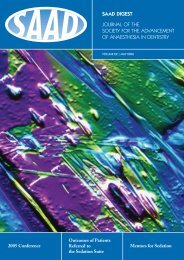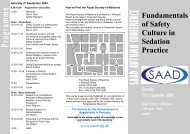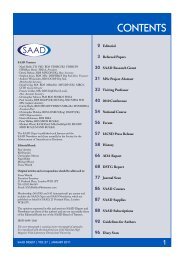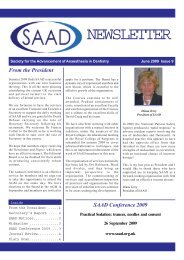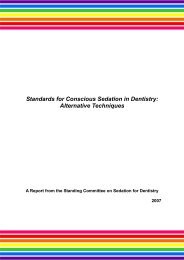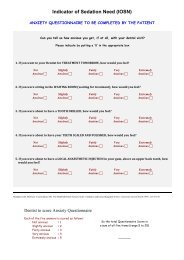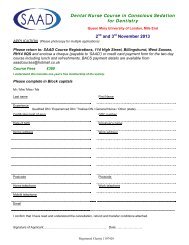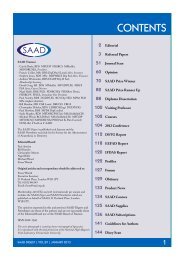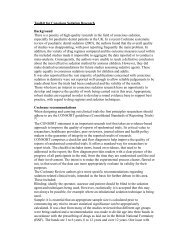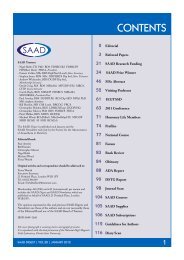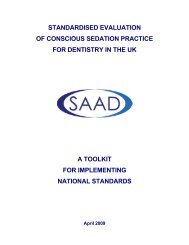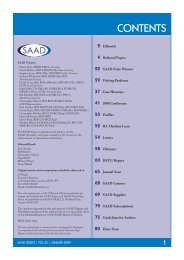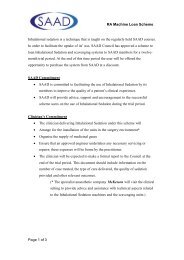Volume 24 - The Society for the Advancement of Anaesthesia in ...
Volume 24 - The Society for the Advancement of Anaesthesia in ...
Volume 24 - The Society for the Advancement of Anaesthesia in ...
Create successful ePaper yourself
Turn your PDF publications into a flip-book with our unique Google optimized e-Paper software.
SAAD DENTAL NURSE PRIZE WINNER<br />
POST-OPERATIVE<br />
NAUSEA AND<br />
VOMITING IN<br />
DENTAL PATIENTS<br />
A Nurse’s View<br />
Sharon Williams RDN DAN DSN Cert Ed<br />
Senior Dental Anaes<strong>the</strong>tic Nurse<br />
Royal Albert Edward Infirmary, Wigan<br />
Aims and <strong>in</strong>tended learn<strong>in</strong>g<br />
outcomes<br />
In <strong>the</strong> study presented <strong>in</strong> this article, <strong>the</strong> aim is to provide<br />
an overview <strong>of</strong> <strong>the</strong> management <strong>of</strong> post-operative<br />
nausea and vomit<strong>in</strong>g with<strong>in</strong> dentistry, emphasis<strong>in</strong>g <strong>the</strong><br />
nurse’s role.<br />
After read<strong>in</strong>g this article, one should be able to:<br />
• describe <strong>the</strong> physical and psychological complications<br />
associated with post-operative nausea and vomit<strong>in</strong>g<br />
• discuss how vomit<strong>in</strong>g is triggered by <strong>the</strong> bra<strong>in</strong><br />
• expla<strong>in</strong> <strong>the</strong> risk factors and how <strong>the</strong> risk assessment tool<br />
works<br />
• look at areas <strong>for</strong> improvement with<strong>in</strong> nurse education <strong>in</strong><br />
<strong>the</strong> management <strong>of</strong> post-operative nausea and vomit<strong>in</strong>g.<br />
Introduction<br />
Post-operative nausea and vomit<strong>in</strong>g (PONV) was first<br />
described <strong>in</strong> 1848 by John Snow (1) , with<strong>in</strong> 18 months<br />
<strong>of</strong> <strong>the</strong> <strong>in</strong>troduction <strong>of</strong> anaes<strong>the</strong>sia to Brita<strong>in</strong>. <strong>The</strong> belief<br />
that anaes<strong>the</strong>tics alone were responsible <strong>for</strong> most cases <strong>of</strong><br />
post-operative nausea and vomit<strong>in</strong>g persisted until 1916<br />
when Flagg reported that it may result from o<strong>the</strong>r causes<br />
<strong>in</strong>clud<strong>in</strong>g pa<strong>in</strong>, reflex responses and <strong>the</strong> use <strong>of</strong> opioids (1) .<br />
PONV is one <strong>of</strong> <strong>the</strong> most common post-operative<br />
complications and can affect as many as 40% <strong>of</strong> patients (2) .<br />
It can cause patient distress, medical complications and has<br />
f<strong>in</strong>ancial implications. <strong>The</strong> aetiology is multi-factoral (1) ,<br />
occurr<strong>in</strong>g <strong>in</strong> all types <strong>of</strong> patients and with all types <strong>of</strong><br />
surgery and anaes<strong>the</strong>tics (3) .<br />
Nurses, <strong>the</strong>re<strong>for</strong>e, spend a lot <strong>of</strong> time com<strong>for</strong>t<strong>in</strong>g and<br />
support<strong>in</strong>g patients. <strong>The</strong>y assess and treat <strong>the</strong> symptoms<br />
caused by PONV, <strong>in</strong>clud<strong>in</strong>g clear<strong>in</strong>g up after episodes <strong>of</strong><br />
sickness and expla<strong>in</strong><strong>in</strong>g <strong>the</strong> problem to patients. It can<br />
delay a patient’s discharge from <strong>the</strong> recovery room and<br />
<strong>in</strong>creases <strong>the</strong> nurse’s workload. Although less than 1%<br />
<strong>of</strong> day surgery patients have to stay <strong>in</strong> hospital overnight<br />
because <strong>of</strong> uncontrollable nausea and vomit<strong>in</strong>g, this<br />
makes it an expensive complication (3) .<br />
Physical complications <strong>of</strong> PONV <strong>in</strong> dental patients<br />
can vary from m<strong>in</strong>or episodes through to more serious<br />
problems, such as (4) :<br />
• general delay <strong>in</strong> mobilisation and recovery<br />
• possible disruption <strong>of</strong> tooth sockets lead<strong>in</strong>g to ongo<strong>in</strong>g<br />
bleed<strong>in</strong>g<br />
• delay <strong>in</strong> giv<strong>in</strong>g oral analgesia and o<strong>the</strong>r medication<br />
• <strong>in</strong>creased pa<strong>in</strong>, discom<strong>for</strong>t and distress<br />
• dehydration<br />
• aspiration <strong>of</strong> vomit with <strong>the</strong> risk <strong>of</strong> aspiration<br />
pneumonia<br />
• obstruction <strong>of</strong> airway.<br />
Psychological effects can also affect <strong>the</strong> patient’s recovery<br />
follow<strong>in</strong>g surgery <strong>in</strong> <strong>the</strong> follow<strong>in</strong>g ways (4) :<br />
• discom<strong>for</strong>t<br />
• shame and embarrassment<br />
• dissatisfaction with <strong>the</strong> outcome <strong>of</strong> dental surgery<br />
• fear <strong>of</strong> fur<strong>the</strong>r dental surgery under general anaes<strong>the</strong>tic.<br />
Nausea and vomit<strong>in</strong>g<br />
Nausea is an unpleasant sensation commonly preced<strong>in</strong>g<br />
vomit<strong>in</strong>g (4) . <strong>The</strong> vomit<strong>in</strong>g reflex is an important defence<br />
mechanism <strong>for</strong> <strong>the</strong> expulsion <strong>of</strong> tox<strong>in</strong>s. <strong>The</strong>re are three<br />
components to <strong>the</strong> vomit<strong>in</strong>g reflex: emetic detectors,<br />
coord<strong>in</strong>at<strong>in</strong>g centres and motor outputs (3) .<br />
• Emetic detectors: <strong>the</strong>se are receptors <strong>in</strong> <strong>the</strong> gut wall<br />
that respond to distension, receptors <strong>in</strong> <strong>the</strong> mucosa <strong>of</strong><br />
<strong>the</strong> stomach and <strong>the</strong> duodenum, monitor <strong>the</strong> <strong>in</strong>ternal<br />
environment. <strong>The</strong> stimulus is carried by <strong>the</strong> vagus nerve<br />
to <strong>the</strong> bra<strong>in</strong> stem (3) .<br />
• Coord<strong>in</strong>at<strong>in</strong>g centres: <strong>the</strong> vomit<strong>in</strong>g centre lies <strong>in</strong>side <strong>the</strong><br />
blood bra<strong>in</strong> barrier <strong>in</strong> <strong>the</strong> medulla. It coord<strong>in</strong>ates <strong>the</strong><br />
control <strong>of</strong> <strong>the</strong> vomit<strong>in</strong>g reflex receiv<strong>in</strong>g signals from <strong>the</strong><br />
pharynx, gastro<strong>in</strong>test<strong>in</strong>al tract and mediast<strong>in</strong>um via <strong>the</strong><br />
vagus nerve. It also receives signals from a portion <strong>of</strong><br />
<strong>the</strong> eighth cranial nerve and <strong>the</strong> chemoreceptor trigger<br />
zone. <strong>The</strong> chemoreceptor trigger zone e (CTZ) lies on<br />
<strong>the</strong> outside <strong>of</strong> <strong>the</strong> blood bra<strong>in</strong> barrier <strong>in</strong> <strong>the</strong> medulla<br />
where it is exposed to circulat<strong>in</strong>g tox<strong>in</strong>s. Stimulation <strong>of</strong><br />
SAAD DIGEST | VOL.<strong>24</strong> | JANUARY 2008 13




